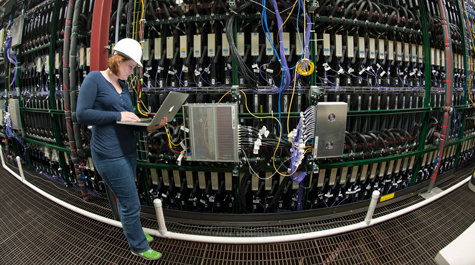William & Mary hosts international neutrino workshop
An international workshop on neutrinos is bringing particle physicists from all over the globe to William & Mary.
NuFact 2012 will be held in Williamsburg July 23-28, jointly sponsored by William & Mary and Jefferson Lab. Jeff Nelson, the Cornelia B. Talbot Term Distinguished Associate Professor of Physics at William & Mary, is one of the organizers of the conference, along with fellow physicists Robert McKeown, Patricia Vahle and Michael Kordosky.
Neutrinos are subatomic particles, enormously abundant, yet extremely difficult to detect. They’re the byproduct of nuclear reactions—sources include the sun, atomic power plants and nuclear activity in the core of the earth. Much of the current investigation of neutrinos focuses on the propensity of these particles to oscillate, or change from one “flavor” to another.
William & Mary physicists continue to contribute to some of the most important neutrino experiments, including investigation at Daya Bay, China, that led to the recent observation of a neutrino-oscillation value known as θ13 (pronounced “theta one-three”) and other neutrino investigations at the U.S. Department of Energy’s Fermi National Accelerator Laboratory (Fermilab).
The 2012 session of the annual gathering is a particularly important one, Nelson says, as the attendees will be discussing the next generation of neutrino sources and the experiments that will be run on them. Recent advancement in the understanding of neutrino behavior, combined with scheduled upgrades to many of the world’s neutrino facilities, have created an enriched environment for neutrino studies in time for the 2012 NuFact gathering.
“Right now we’re looking for the next generation of proton machines,” Nelson explained. “We’re calling them the superbeams, where the idea is simply to put more power onto your target to produce more neutrinos in the same way that we do in our current experiments.”
Key to neutrino advancements, he said, is knowing the value of θ13. In light of the recently discovered value of θ13, a principal focus of the workshop will be on how to optimize future superbeams as well as the proposed neutrino factory, a muon beam-based facility that is the namesake of the NuFact workshop series.
“Now we know what we’re looking for, and how hard we’ll have to work to get there,” Nelson said. “We’re going to look for whether neutrinos and antineutrinos behave the same way, which we think is the key towards understanding why we live in a matter-dominated universe instead of an anti-matter-dominated universe or an energy-dominated universe.”
NuFact workshops are among the top annual events in the neutrino physics world. “Last year’s workshop was held in Geneva, Switzerland, with CERN right there and the Alps as a backdrop,” Nelson said. “That’s going to be a hard act to follow, but we’ve got a solid event lined up.”
He expects the international physics community to be well represented at William & Mary, with 150 scientists representing 16 countries.















